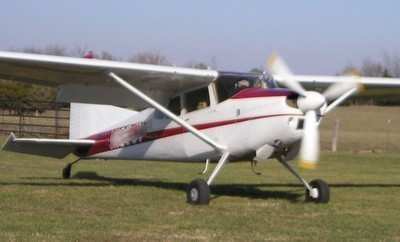Jump Door Opened During Takeoff
 "First, Fly The Airplane" is a phrase we all have heard since
our primary flight training. One person was fatally injured August
1st when a Cessna Skywagon carrying a group of skydivers went down
after a door came open during takeoff.
"First, Fly The Airplane" is a phrase we all have heard since
our primary flight training. One person was fatally injured August
1st when a Cessna Skywagon carrying a group of skydivers went down
after a door came open during takeoff.
NTSB Identification: ERA10LA389
14 CFR Part 91: General Aviation
Accident occurred Sunday, August 01, 2010 in Newfane, NY
Aircraft: CESSNA A185F, registration: N4976E
Injuries: 6 Serious.
This is preliminary information, subject to change, and may
contain errors. Any errors in this report will be corrected when
the final report has been completed.
On August 1, 2010, about 1420 eastern daylight time, a Cessna
A185F, N4976E, was substantially damaged when it impacted trees,
during the initial climb after takeoff from Hollands International
Airport (85N), Newfane, New York. The certificated commercial pilot
and four passengers were seriously injured. One passenger was
killed. Visual meteorological conditions prevailed and no flight
plan had been filed for the local skydiving flight that was
conducted under the provisions of Title 14 Code of Federal
Regulations Part 91.
During a telephone interview, the pilot reported that he had
completed seven or eight uneventful flights prior to the accident.
A jump instructor was on board the accident flight, with a student
and a videographer; and two additional "experienced" jumpers. The
two jumpers intended to exit the airplane at an altitude of 5,000
feet, and the parachute instructor intended to conduct a tandem
jump with the student from an altitude of 12,500 feet.
The flight departed from runway 25, a 2,875-foot-long,
75-foot-wide, turf runway. The airplane accelerated and lifted off
normally; however, during rotation the jump door, located on the
right side of the airplane, opened. The pilot said he was not
concerned with the door, which would not have critically impacted
the airplane's performance; however, one of the experienced
parachutists attempted to secure the door. The pilot yelled at him
to stop, however, the parachutist continued to attempt to secure
the door to the point where he was partially outside of the
airplane. The pilot physically grabbed the parachutist and tired to
pull him back into the airplane. During this time, the pilot became
distracted, which resulted in the airplane veering left toward
trees, while flying at a low airspeed. The airplane subsequently
struck a stand of trees and impacted the ground.

Cessna 185 File Photo
The airplane came to rest inverted in a wooded area, with the
roof of the cabin and empennage separated.
Examination of the airplane by a Federal Aviation Administration
(FAA) inspector did not reveal any mechanical malfunctions. In
addition, the pilot reported that the airplane performed as
expected, without any mechanical issues.
The inspector noted that the jump door, which was hinged to open
upward, was separated and in the latched position. The jump door
and surrounding structure were distorted due to impact damage.
The videographer noted that the door was checked prior to
takeoff and appeared to be secured.
The pilot reported 4,010 hours of total flight experience on his
most recent application for an FAA second-class medical
certificate, which was dated April 27, 2010. He estimated that he
had flown about 300 hours in the accident airplane.
The reported weather at an airport located about 12 miles
southwest of the accident site, at 1353, was: wind from 110 degrees
at 3 knots; visibility 10 statute miles; few clouds at 4,800 feet,
scattered clouds at 12,000 and 25,000 feet; temperature 28 degrees
Celsius (C); dew point 16 degrees C; altimeter 29.98 inches of
mercury.
 SpaceX to Launch Inversion RAY Reentry Vehicle in Fall
SpaceX to Launch Inversion RAY Reentry Vehicle in Fall Aero-News: Quote of the Day (04.23.24)
Aero-News: Quote of the Day (04.23.24) Aero-News: Quote of the Day (04.20.24)
Aero-News: Quote of the Day (04.20.24) ANN's Daily Aero-Linx (04.20.24)
ANN's Daily Aero-Linx (04.20.24) Aero-News: Quote of the Day (04.21.24)
Aero-News: Quote of the Day (04.21.24)




